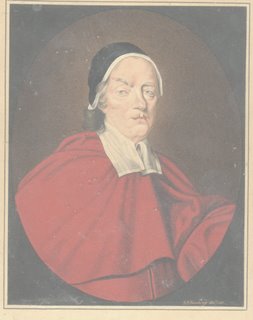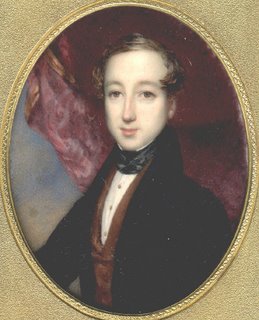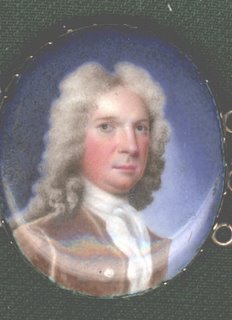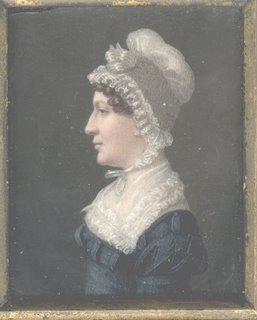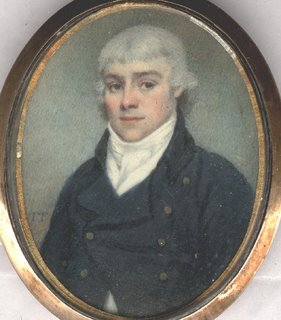
Collecting miniature portraits is sometimes like a lucky dip as one never knows quite what will come up next. Although this portrait is a little larger than a miniature, 140mm x 110mm, and drawn in pencil, the sitter was a controversial historical figure.
The portrait is dated 1868 on the reverse, but the seller did not know the sitter, so it was sold as an unidentified sitter.
But I had recently been researching the famous surgeon, Sir Anthony Carlisle and, by chance, had seen the identical image in connection with Sir Anthony Carlisle, as he had performed an autopsy on the sitter's death, to settle major differences of public opinion as to whether the sitter was male or female.
Thus I recognised the sitter as the Chevalier d'Eon, a real historical character, who has given rise to an adult cartoon character of the same name who apparently even features in books and films, and on television, as shown below. Even a London play in 1999 by Mark Brownell.


Of all the ambassadors or diplomatists who ever served a sovereign, the most extraordinary, perhaps, was the Chevalier d'Eon, who occupied a large space in the public mind at certain periods; extraordinary, not for his political abilities or services, but for his personal history.
The story of Chevalier d'Eon commences on 5 October 1728, in a French town of Tonnerre, when Charles-Genevieve Louis-Auguste-Andre-Timothee was born. His father was an advocate in the high court of justice, Louis d'Eon de Beaumont and his mother was lady Francoise de Chavanson.
There was no doubt about his gender when he was born. The doctor, midwife, and other people present in the household when d'Eon was born confirmed he was male. He grew up in a normal schoolboy style, although his mother was said to sometimes dress him in his sister's clothes. This was not unusual in even in the 19C and early 20C ,as many young boys appear in miniatures dressed as girls. As a young man he reputedly had a slight, small body and delicate formed limbs, with a slender waist and small hands and feet. d'Eon completed his education in College Mazarin in Paris and became successively a doctor in civil law, a doctor in canon law, and an advocate before the tribunals of Paris. He wrote several books which attracted attention and became secretary to Monsieur de Sauvigny, the fiscal administrator in Paris.
In 1756 d'Éon joined the secret network of spies called Le Secret du Roi which worked for King Louis XV. Louis XV wanted to reconcile with Russia at that time. He sent two ambassadors to discuss the issue with Russia Empress Elisabeth but failed because the men were banned to the court. In order to penetrate into the court and successfully discuss the issue with Empress Elisabeth, he needed to send a woman, but a woman could not handle the dangerous mission. Louis XV, always liking a bit of spicy intrigue to brighten his day, and believing that a French woman (who were renowned everywhere for their charm, diplomacy and guile but not for their intelligence) might get through Elizabeth's door where a male diplomat could not; he hit on the idea of sending a 'lady' diplomat - an intelligent and gifted man in the guise of a woman - to Russia. His gaze fell on the fresh faced d'Eon who also had all the other qualities he needed - and Charles was 'persuaded' to go to Russia as "Lia de Beaumont'', his own "sister'', in robes of the latest Parisian fashion, with suitably forged documents proving "her" parentage and patronage.
The ruse worked brilliantly. "Lia" was able to spend many hours in the company of Empress Elizabeth and persuaded her to write to Louis and invite a new ambassador to Moscow,. "Lia" took a very strong liking to this highly pampered feminine lifestyle, but was soon back in Paris to report his success. Unbelievably he was re-despatched to Moscow by Louis XV in his male role - as an embassy secretary.
But d'Eon proceeded to be both Charles at the embassy and "'Lia" at the Russian Court, carving (for those few important people in the know in France) an enviable reputation as a spy in the process! After a few years - when it was believed in Paris his double life was about to be exposed - he was withdrawn.
d'Eon became known in England in 1761, the year after George III ascended the throne. England and France, after many years of war, were making overtures of conciliation and the Duke de Nivernois was sent by Louis XV as ambassador to negotiate the terms of peace. Chevalier d'Eon, who accompanied him as secretary, won general favour at court; he was of prepossessing appearance, managed the duties of his position with much ability, and displayed a wide range of accomplishments.
While in London, d'Eon continued his dual role as a top spy; both Charles and "Lia" became an accepted part of the English Court and of the social scene around London. They were, of course, never seen together! One strange manifestation of this - and one that was very popular as a diversion with the public - was that of "Lia" d'Eon, the lady fencer, challenging the best swordsmen in or visiting the City!
When the duke had completed the terms of peace, d'Eon had the honour of communicating the fact from the one sovereign to the other. The court-journal of 1763 announced:
"Monsieur d'Eon de Beaumont, secretary to the embassy from France, returned this day to London, and was received by the Duke de Nivernois as Knight of the Royal Military Order of St. Louis: his Most Christian Majesty having invested him with that order, when he presented to him the ratification of the definitive treaty of peace with England."

Madame de Pompadour, who held an influential position at the court of Versailles, wrote about the same time to the Duke de Nivernois, mentioning d'Eon in the following terms:
'This M. d'Eon is, I am told, a very good sort of man, who has served the king in more countries than one: and the English have been very polite in giving him the treaty to bring. This, I doubt not, will be of some advantage to him.'When the Duke de Nivernois returned to France on completion of his mission, he strongly recommended d'Eon as the temporary representative of France in England, until a permanent ambassador could be appointed. So well had d'Eon conducted himself, that both monarchs assented to this and in 1763 d'Éon became plenipotentiary minister in London. Soon afterwards three distinguished Frenchmen, Lalande, La Condamine, and Camus, were introduced to George III by d'Eon. d'Eon used his position to spy for the king and collect information for a potential invasion. He formed connections with English nobility by sending them the produce of his vineyard. This was the only short brilliant period of d'Eon's life and was followed by disgrace.
Louis XV then appointed the Count de Guercy his permanent ambassador in England, and directed d'Eon to resume his former position as secretary of the embassy, with aome additional honours as a reward for his service.
When he was about to lose the post of plenipotentiary, he complained, and eventually decided to disobey orders to return to France. In his letter to the king, he claimed that the new ambassador had tried to drug him. In an effort to save his station in London, he published most of the secret diplomatic correspondence about his recall under the title "Lettres, mémoires, et négociations" in 1764, including an accusation against the Count de Guercy. The count brought an action against d'Eon in the Court of King's Bench for libel. d'Eon made neither an appearance nor a defence, and the verdict was given against him.
As a result, the French authorities were anxious to arrest him, and even sanctioned a forcible entry into a house in Scotland Yard, where he was supposed to be residing; but d'Eon eluded them. Towards the close of 1764, d'Eon charged the Count de Guercy of conspiracy to murder or injure him, In response, the count, instead of rebutting the charge, claimed his privileges as a foreign ambassador, thus the public formed the opinion that the conspiracy charge was perhaps justified.
To resolve the issue without further diplomatic incident, in 1766, Louis XV granted d'Eon a 12,000 livre annuity, provided be became a woman and continued to work as a spy, and lived in political exile in London.

After some speculation, in July 1777, an action was brought to the Courts seeking to determine the sex of d'Eon. Despite the fact that d'Éon wore his dragoon's uniform all the time, there were rumors that he was actually a woman and a betting pool was eventually started on the London Stock Exchange regarding the truth of his gender. The enormous sum of £70,000O was mentioned in connection with the pool. One man, on evidence which seemed to him convincing, had made a wager that d'Eon was a woman, and brought an action to recover the amount of the bet.
D'Eon was invited to give evidence to resolve the claim, but declined, saying that an examination would be dishonouring, whatever gender was discovered. After a year without progress, the wager was abandoned. From that time d'Eon became regarded as Madame d'Eon, and assumed female attire. In 1774, after the death of Louis XV, d'Éon tried to negotiate his return from exile. The French government's side of the negotiations were handled by the writer Pierre de Beaumarchais. D'Éon claimed that physically he was not a man, but a woman, and demanded that the government recognize him as a woman. King Louis XVI and his court complied but demanded that he dress appropriately and wear women's clothing. D'Éon agreed, especially when the king granted him funds for a new wardrobe. In 1777 d'Éon returned to France, and afterwards lived as a woman.
In 1779 d'Éon published his memoirs "La Vie Militaire, politique, et privée de Mademoiselle d'Eon". They were ghostwritten by a friend named La Fortelle, and are probably embellished. In them it was claimed d'Eon was born at Tonnerre, as female but, for the purpose of advancing his prospects in life was treated as a boy.
D'Éon returned to England in 1785, having lost his pension after the French Revolution. In 1792 he sent a letter to the French National Assembly, offering to lead a division of women soldiers against the Habsburgs, but the offer was rebuffed. He participated in fencing tournaments until he was seriously wounded in 1796. In 1805 he signed a contract for an autobiography, but the book was never published and he spent his last years with a widow, Mrs. Cole.
At length, on 22 May 1810, the news-papers announced that the 'celebrated Chevalier d'Eon' had died at the Millman Street Foundling Hospital. Sir Anthony Carlisle performed the autopsy. Thus it became decisively known that d'Eon was really a man but, for reasons known to himself, had passed himself off as a woman. 1364
 This miniature is possibly an early portrait of the fam0us Scottish writer Thomas Carlyle (1795-1881). For much more about him see Thomas Carlyle
This miniature is possibly an early portrait of the fam0us Scottish writer Thomas Carlyle (1795-1881). For much more about him see Thomas Carlyle
 The other two portraits are of Carlyle at a youngish age, although none seem to be as early as 1816, as they both appear to show sideburns. Sideburns were not fashionable for men in 1816 and it was really after 1820 that they became fashionable. White neck wear as in the miniature was fashionable up to around 1820, with black neck ties as shown in the other portraits, becoming the dominant colour by around 1830.
The other two portraits are of Carlyle at a youngish age, although none seem to be as early as 1816, as they both appear to show sideburns. Sideburns were not fashionable for men in 1816 and it was really after 1820 that they became fashionable. White neck wear as in the miniature was fashionable up to around 1820, with black neck ties as shown in the other portraits, becoming the dominant colour by around 1830.












